
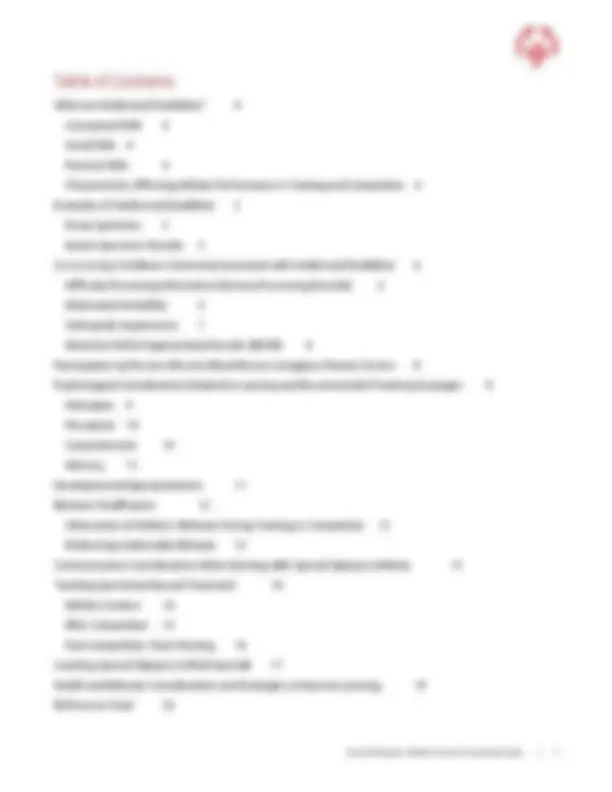
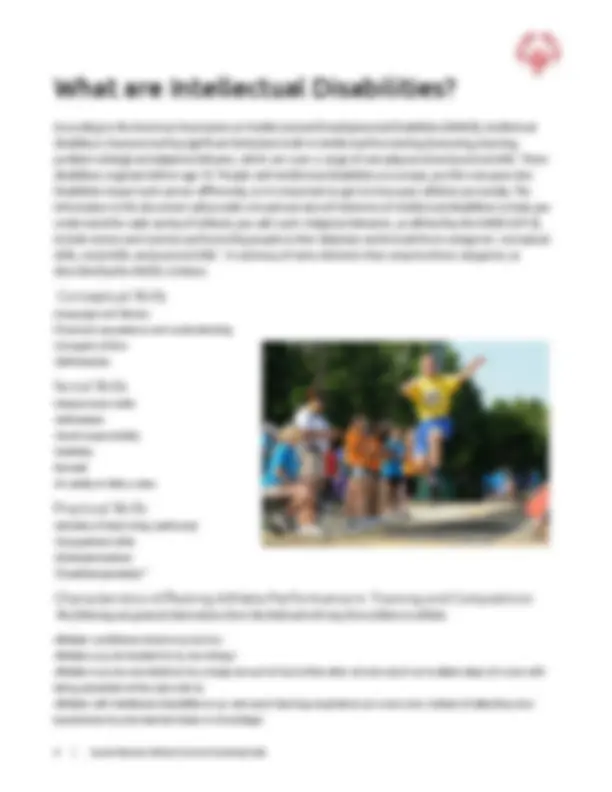
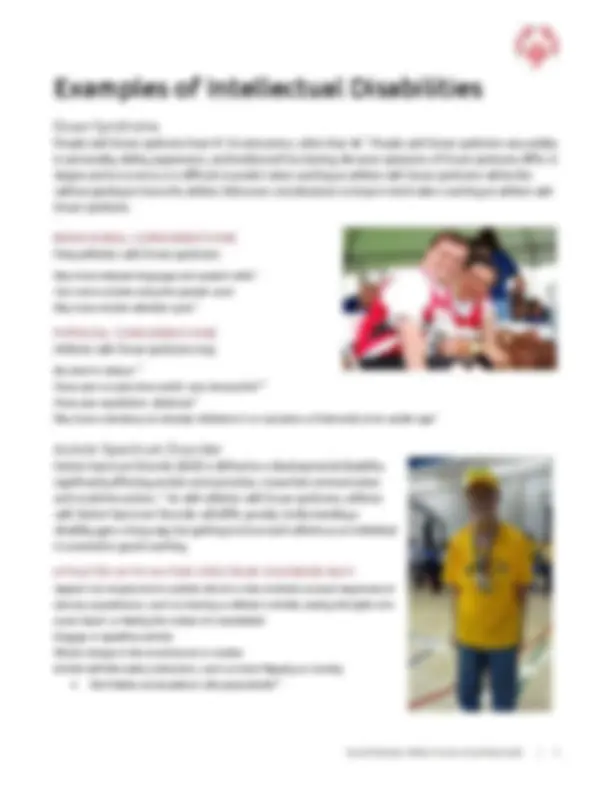
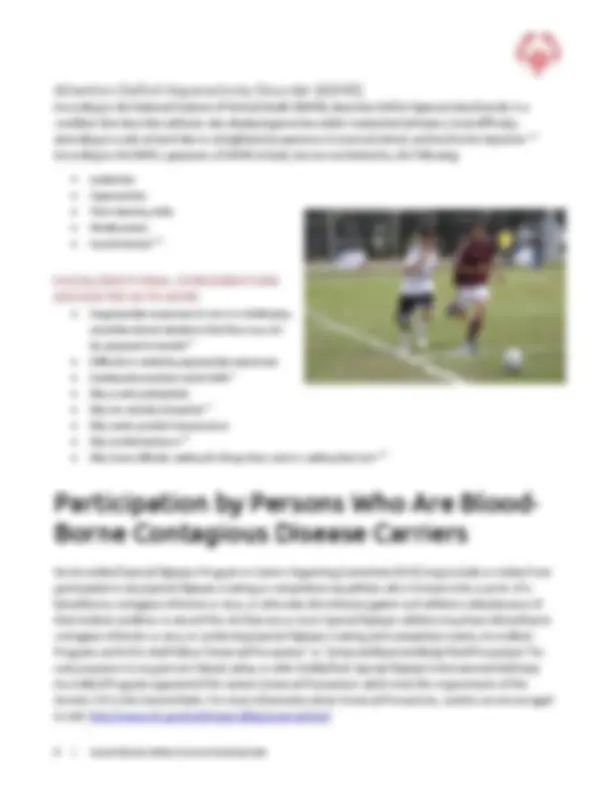
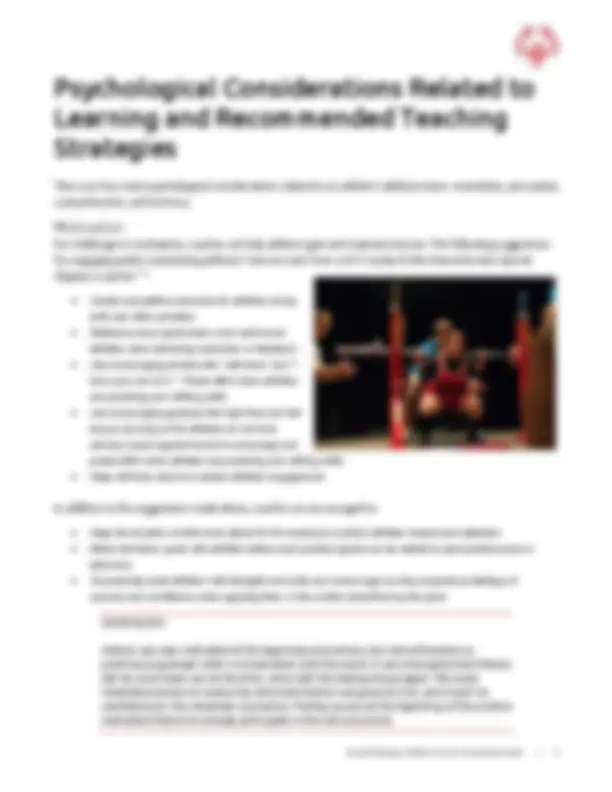
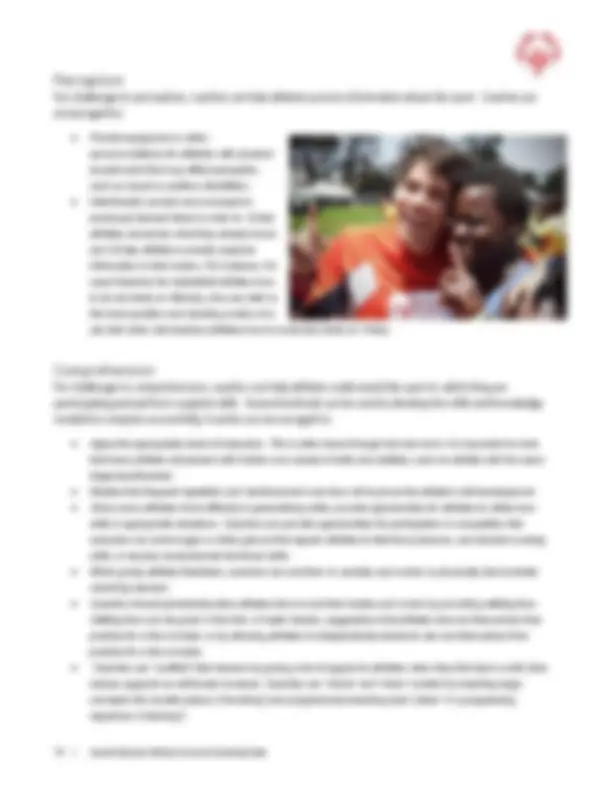
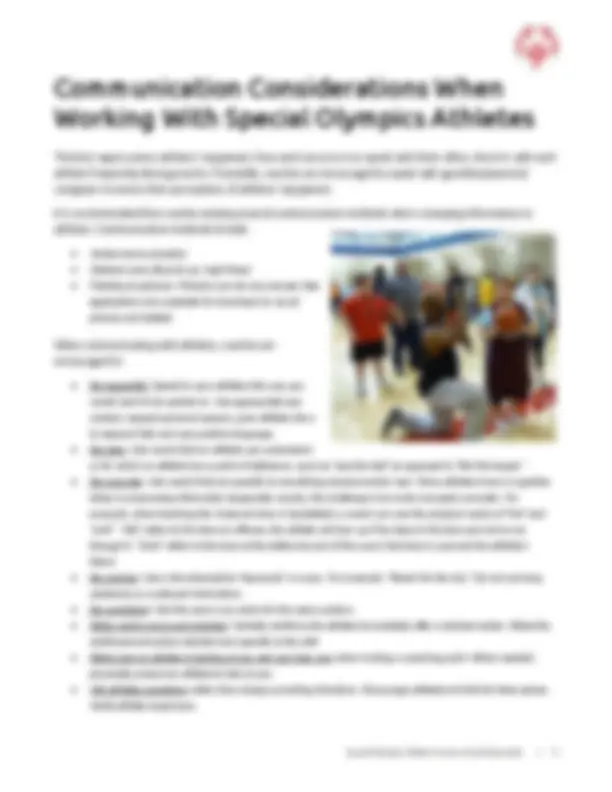
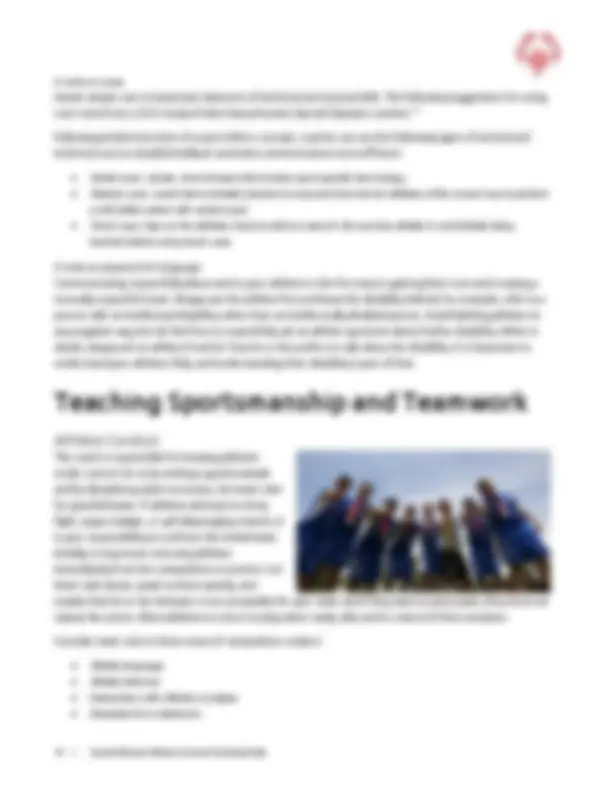
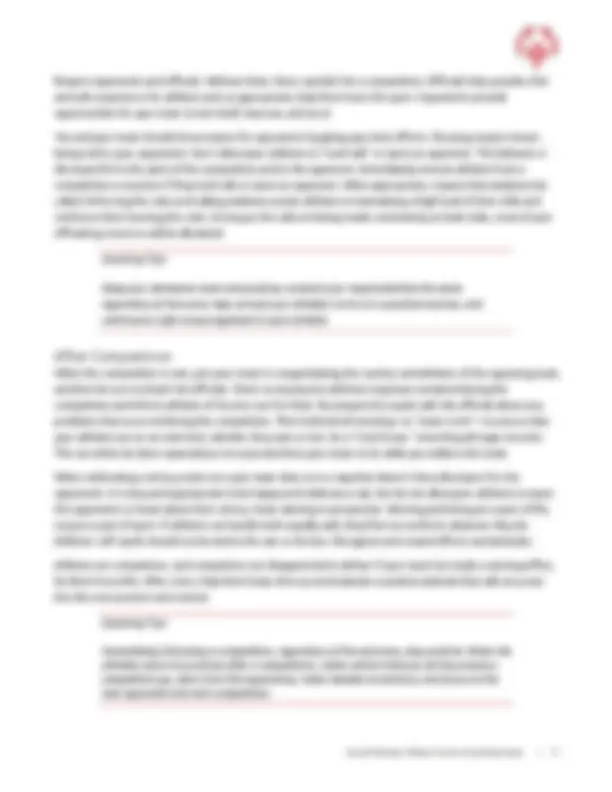
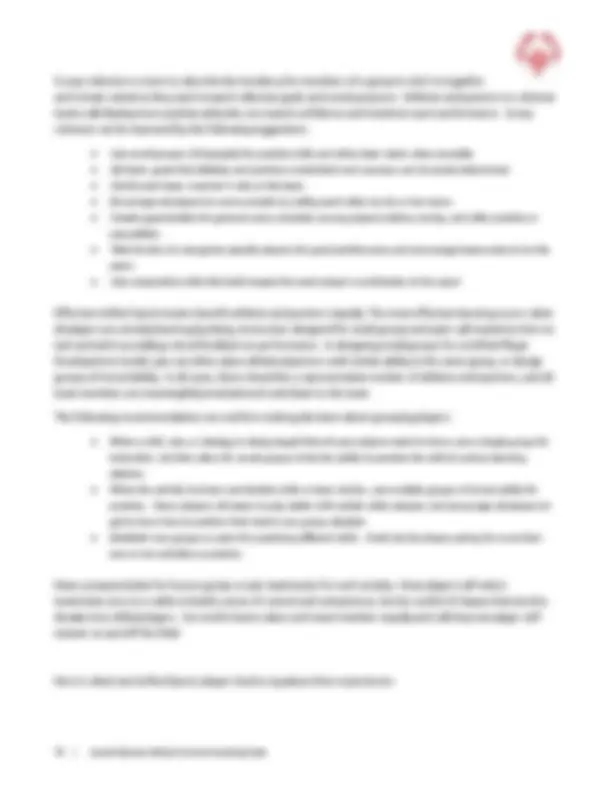
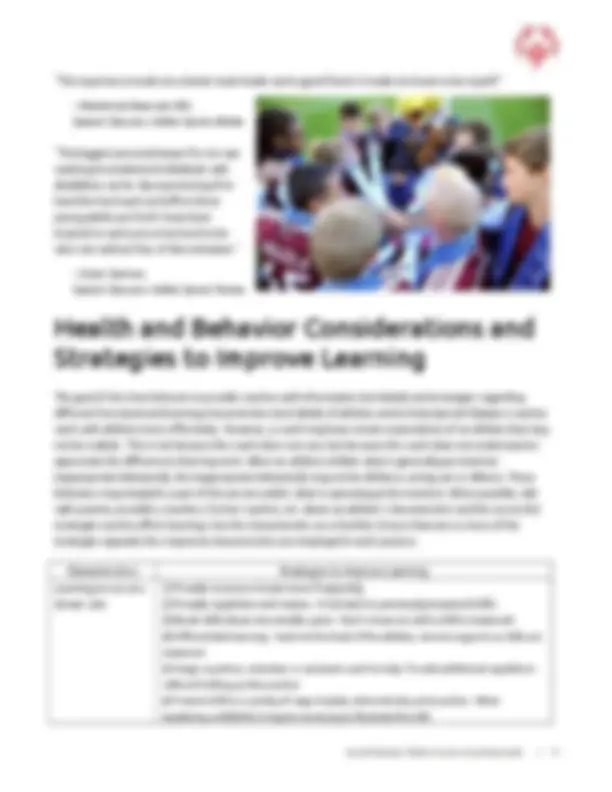
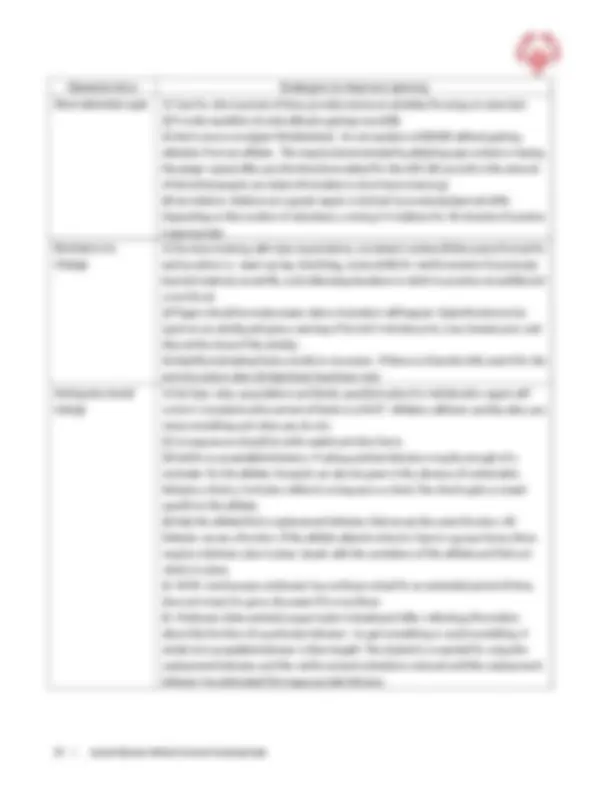
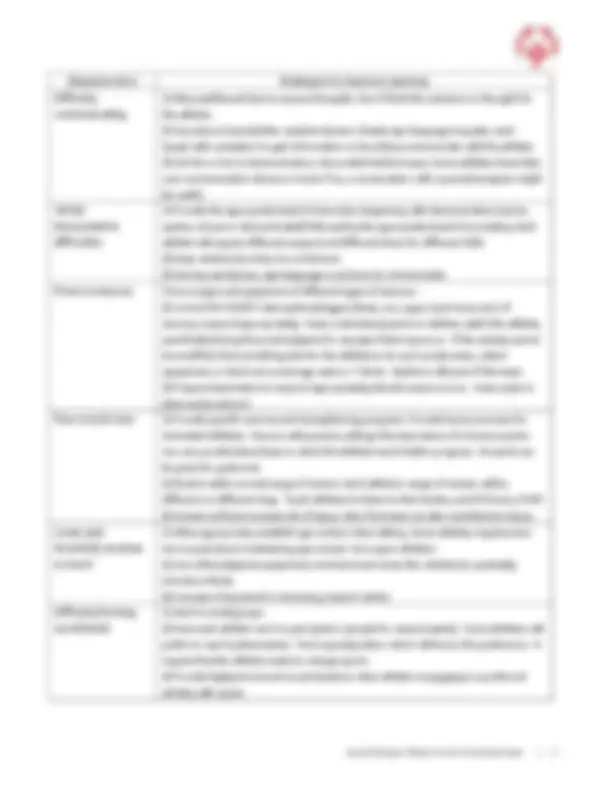
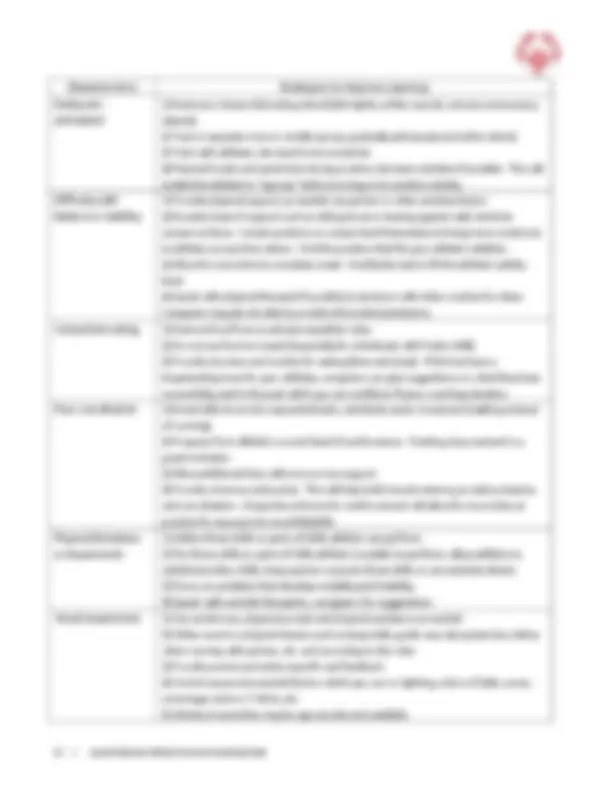
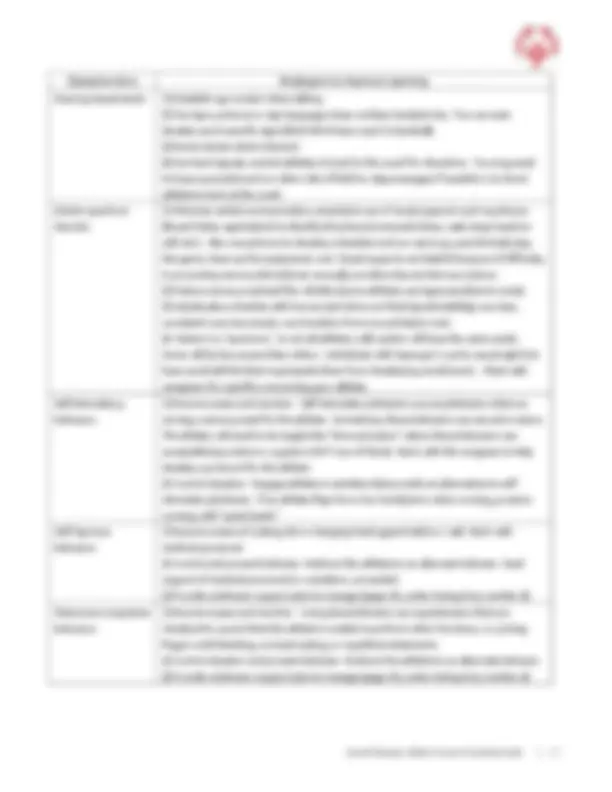
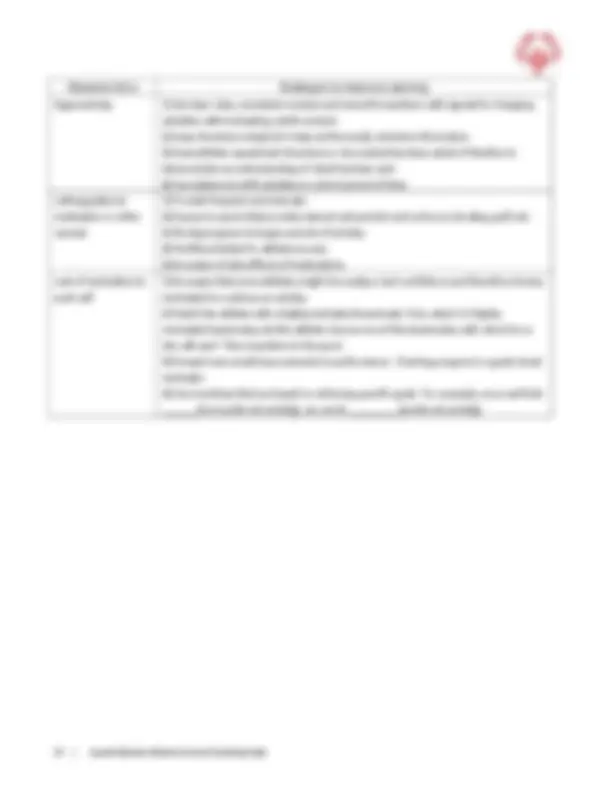
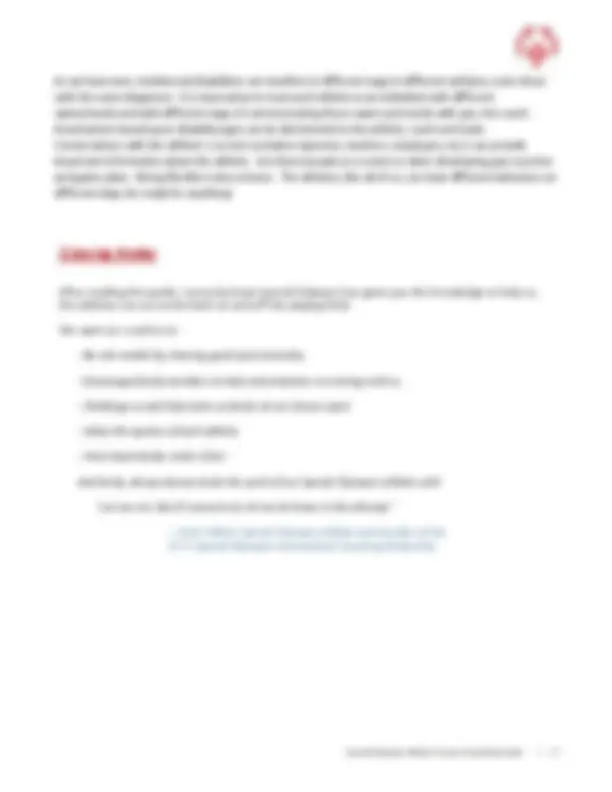
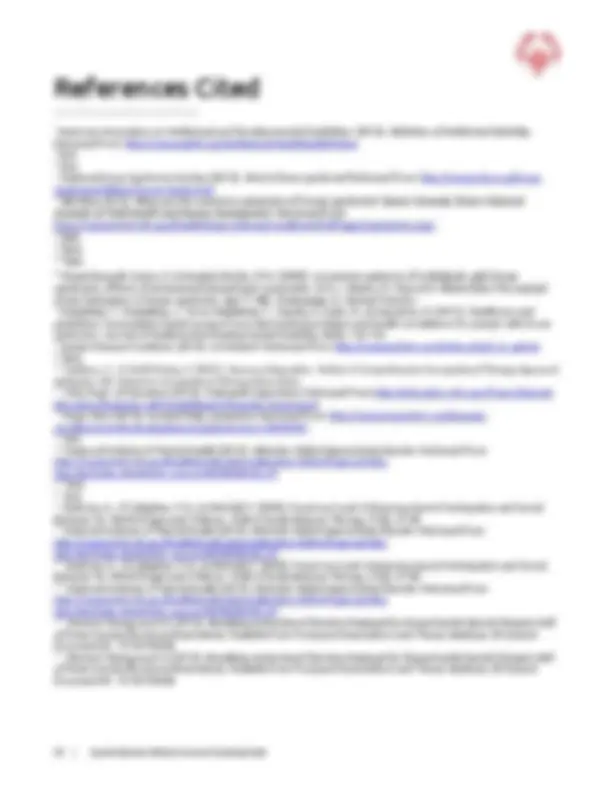


Study with the several resources on Docsity

Earn points by helping other students or get them with a premium plan


Prepare for your exams
Study with the several resources on Docsity

Earn points to download
Earn points by helping other students or get them with a premium plan
Community
Ask the community for help and clear up your study doubts
Discover the best universities in your country according to Docsity users
Free resources
Download our free guides on studying techniques, anxiety management strategies, and thesis advice from Docsity tutors
Insights into intellectual disabilities, specifically those related to athletes with autism spectrum disorder and ADHD. It covers common co-occurring conditions, social and emotional considerations, and participation guidelines. Coaches will find valuable tips on motivation, perception, comprehension, memory, and developmental appropriateness. The guide also introduces Unified Sports and discusses health and behavior considerations.
What you will learn
Typology: Study notes
1 / 26

This page cannot be seen from the preview
Don't miss anything!



















Special Olympics Athlete-Centered Coaching Guide | 1
As athletes, we want our coaches to be dedicated to the team by committing to learn more, not only about their sport but also the athletes. We want our coaches to know our individual strengths, weaknesses, and the personality traits that make us unique from our fellow teammates.
As an athlete, I expect my coaches to:
_- Put me in a position to be successful and challenge me to help realize my potential.
2 | Special Olympics Athlete-Centered Coaching Guide
Acknowledgements
This guide is a general introduction to coaching adults and children with intellectual disabilities. This guide also includes a section focusing on some behaviors commonly associated with intellectual disabilities and effective strategies to improve athlete learning.
Since this is a general guide, it is suggested that you consult as many resources as possible when meeting and learning about your athletes. Resources include: the athlete, his or her family members or guardians, teachers, employers, and others. Remember, athletes are unique individuals with unique interests, likes and dislikes, and varying ways of expression.
Please note: References provided in this guide are listed at the end.
In addition, this guide was created as part of the U.S. Department of State-funded Special Olympics Coaching Fellowship. Thank you to the 2013 American Fellows for their dedication and enthusiasm writing this guide and to their fellow athletes and coaches in Special Olympics. Their efforts and expertise produced this user-friendly guide that is athlete centered and coach driven so athletes are provided appropriate levels of instruction, challenging yet achievable activities, and meaningful outcomes.
Linda Costello-Roth, Special Education teacher and administrator, Huntington, New York; certified coach, Special Olympics New York
John Ford, Senior Claims Examiner, Commerce Insurance Company; Massachusetts Youth Soccer – E, F and G licenses; Football Association of Ireland – Level 1; National Soccer Coaches Association of America – Regional and Advanced Regional; certified coach, Special Olympics Massachusetts
Ilima Kane, Community Engagement Grants Director, Colorado Foundation for Public Health and the Environment; certified coach, Special Olympics Colorado (soccer, skiing and flag football)
Matt Millett, athlete, Special Olympics Massachusetts; Institute Security Officer, Justice Resource Institute; participated in the first Special Olympics Unity Cup, Cape Town, South Africa
Rebecca Shangraw, Ed.D., Physical Education Department Head, Landmark College, Putney, Vermont; certified coach, Special Olympics Massachusetts (basketball, softball, soccer and Unified Sports)
4 | Special Olympics Athlete-Centered Coaching Guide
What are Intellectual Disabilities?
According to the American Association on Intellectual and Developmental Disabilities (AAIDD), intellectual disability is characterized by significant limitations both in intellectual functioning (reasoning, learning, problem-solving) and adaptive behavior, which can cover a range of everyday social and practical skills. These disabilities originate before age 18.i^ People with intellectual disabilities are unique, just like everyone else. Disabilities impact each person differently, so it is important to get to know your athletes personally. The information in this document will provide a broad overview of elements of intellectual disabilities to help you understand the wide variety of athletes you will coach. Adaptive behaviors, as defined by the AAIDD (2013), include actions and routines performed by people in their daily lives and include three categories: conceptual skills, social skills, and practical skills.ii^ A summary of some elements that comprise these categories, as described by the AAIDD, is below:
Language and literacy Financial competence and understanding Concepts of time Self-direction
Interpersonal skills Self-esteem Social responsibility Gullibility Naiveté An ability to follow rules
Activities of daily living (self-care) Occupational skills Schedule/routines Travel/transportationiii
The following are general observations from the field and will vary from athlete to athlete.
Athletes’ confidence levels may be low. Athletes may be hesitant to try new things. Athletes may be overwhelmed by a large amount of new information at once (such as multiple steps of a new skill being presented at the same time). Athletes with intellectual disabilities may view each learning experience as a new one, instead of attaching new experiences to prior-learned ideas or knowledge.
Special Olympics Athlete-Centered Coaching Guide | 5
Examples of Intellectual Disabilities
People with Down syndrome have 47 chromosomes, rather than 46.iv^ People with Down syndrome vary widely in personality, ability, appearance, and intellectual functioning. Because symptoms of Down syndrome differ in degree and occurrence, it is difficult to predict what coaching an athlete with Down syndrome will be like without getting to know the athlete. Below are considerations to keep in mind when coaching an athlete with Down syndrome.
BEHAVIORAL CONSIDERATIONS Many athletes with Down syndrome:
May have delayed language and speech skills v Can communicate using the spoken word May have shorter attention spanvi
PHYSICAL CONSIDERATIONS Athletes with Down syndrome may:
Be short in stature vii Have poor muscle tone and/or very loose joints viii Have poor equilibrium (balance) ix May have a tendency to develop Alzheimer’s or symptoms of dementia at an earlier age x
Autism Spectrum Disorder (ASD) is defined as a developmental disability significantly affecting verbal communication, nonverbal communication and social interactions .xi^ As with athletes with Down syndrome, athletes with Autism Spectrum Disorder will differ greatly. Understanding a disability goes a long way, but getting to know each athlete as an individual is essential to good coaching.
ATHLETES WITH AUTISM SPECTRUM DISORDER MAY: Appear non-responsive to outside stimuli or demonstrate unusual responses to sensory experiences, such as hearing a referee’s whistle, seeing the lights of a score board, or feeling the rubber of a basketball Engage in repetitive activity Resist change in the environment or routine Exhibit self-stimulatory behaviors, such as hand flapping or rocking Not initiate conversations with peers/adults xii
Special Olympics Athlete-Centered Coaching Guide | 7
a determination, who certifies that the athlete may participate and the athlete, or the parent or guardian of a minor athlete, has signed an informed consent acknowledging they have been informed of the findings and determinations of the physician. The statements and certifications required by this subsection shall be documented and provided to Accredited Programs using the standardized form approved by SOI, entitled "Special Release for Athletes with Symptomatic Spinal Cord Compression and/or symptomatic Atlanto-axial Instability," and any revisions of that form, approved by SOI (the "Special Release Concerning Spinal Cord Compression and/or symptomatic Atlanto-axial Instability" ).
An orthopedic impairment is a severe impairment of the skeletal system and associated structures of muscles and ligaments that negatively impact quality of life or the ability to independently perform activities of daily living (ADLs). The term includes impairments caused by birth defects, impairments caused by disease (such as poliomyelitis, bone tuberculosis), and impairments from other causes (such as cerebral palsy, amputations and fractures, or burns that cause contractures). Orthopedic impairments can be classified in three categories: neuromotor impairments (such as spina bifida and cerebral palsy), degenerative diseases (such as muscular dystrophy), and musculoskeletal diseases (rheumatoid arthritis).xiv^ Due to the broad nature of orthopedic impairments, it is difficult to generalize what symptoms an individual might have. Some possible symptoms of orthopedic impairments include, but are not limited to, the following:
Abnormal reflex development Difficulty in coordinating and integrating basic movement patternsxv Speech impairmentsxvi Sensory impairments (visual motor control)
8 | Special Olympics Athlete-Centered Coaching Guide
According to the National Institute of Mental Health (NIMH), Attention Deficit Hyperactivity Disorder is a condition that describes athletes who display hyperactive and/or inattentive behaviors, have difficulty attending to a task at hand due to a heightened awareness to external stimuli, and tend to be impulsive.xvii According to the NIMH, symptoms of ADHD include, but are not limited to, the following:
Inattention Hyperactivity Poor listening skills Restlessness Impulsivenessxviii
Inappropriate responses to new or challenging social/emotional situations that they may not be prepared to handle xix Difficulty in selecting appropriate responses Inadequate practical social skillsxx May avoid participation May be verbally disruptivexxi May seek constant reassurance May exhibit tantrumsxxii May have difficulty waiting for things they want or waiting their turnxxiii
Participation by Persons Who Are Blood-
Borne Contagious Disease Carriers
No Accredited Special Olympics Program or Games Organizing Committee (GOC) may exclude or isolate from participation in any Special Olympics training or competition any athlete who is known to be a carrier of a blood-borne contagious infection or virus, or otherwise discriminate against such athletes solely because of that medical condition. In view of the risk that one or more Special Olympics athletes may have a blood-borne contagious infection or virus, in conducting Special Olympics training and competition events, Accredited Programs and GOCs shall follow “Universal Precautions” or “Universal Blood and Body Fluid Precautions” for every exposure to any person's blood, saliva, or other bodily fluid. Special Olympics International shall keep Accredited Programs apprised of the written Universal Precautions which meet the requirements of this Section 2.05 in the General Rules. For more information about Universal Precautions, coaches are encouraged to visit: http://www.cdc.gov/niosh/topics/bbp/universal.html.
10 | Special Olympics Athlete-Centered Coaching Guide
For challenges in perception, coaches can help athletes process information about the sport. Coaches are encouraged to:
Provide equipment or other accommodations for athletes with physical impairments that may affect perception, such as visual or auditory disabilities. Intentionally connect new concepts to previously learned ideas in order to 1) help athletes remember what they already know and 2) help athletes correctly organize information in their brains. For instance, if a coach teaches her basketball athletes how to do set shots on Monday, she can refer to the hand position and shooting motion of a set shot when she teaches athletes how to make foul shots on Friday.
For challenges in comprehension, coaches can help athletes understand the sport in which they are participating and perform requisite skills. Several methods can be used to develop the skills and knowledge needed to compete successfully. Coaches are encouraged to:
Apply the appropriate level of instruction. This is often done through trial and error. It is important to note that every athlete will present with his/her own subset of skills and abilities, even an athlete with the same diagnoses/disorder. Realize that frequent repetition and reinforcement over time will improve the athlete's skill development. Since some athletes have difficulty in generalizing skills, provide opportunities for athletes to utilize new skills in appropriate situations. Coaches can provide opportunities for participation in competition-like scenarios via scrimmages or other games that require athletes to feel time pressure, use decision-making skills, or employ newly-learned technical skills. When giving athletes feedback, coaches can ask them to verbally summarize or physically demonstrate what they learned. Coaches should periodically allow athletes time to rest their bodies and minds by providing settling time. Settling time can be given in the form of water breaks; suggestions that athletes remove themselves from practice for a few minutes; or by allowing athletes to independently decide to remove themselves from practice for a few minutes. Coaches can “scaffold” their lessons by giving a lot of support to athletes when they first learn a skill, then reduce supports as skill levels increase. Coaches can “chunk” and “chain” content by breaking large concepts into smaller pieces (“chunking”) and progressively teaching each “piece” in a progressing sequence (“chaining”).
Special Olympics Athlete-Centered Coaching Guide | 11
Coaching tips
Structure your season to use early practices to teach basic skills and provide opportunities for team play. Then build on those basic skills and team play each following practice. Planning the whole season of practices will make it easier to modify your practices to fit the unique needs of your team and still ensure you will be ready for competition.
For challenges with memory, coaches can help athletes remember and perform skills at the appropriate time. Coaches are encouraged to repeat and refer to previously learned skills often and in different scenarios/contexts. This will increase muscle memory in the athletes, freeing up brain power to focus on the next level of skill/game development.
Developmental Appropriateness
When working with any athlete population, it is important for coaches to ask athletes to perform technical skills (fundamentals) and tactical skills (game or event strategies) that are developmentally appropriate relative to athletes’ physical and intellectual capabilities. Introducing skills that are too advanced for athletes’ capabilities can lead to unsafe sport environments and frustration. For instance, it would be inappropriate for a soccer coach working with 6-year-olds to ask her athletes to practice slide tackles, because the physical and intellectual processing skills required to successfully perform slide tackles are not yet present in 6-year-olds.
Conversely, asking athletes to perform skills that are not challenging and do not promote skill development can lead to boredom and regression of skill level. A challenge faced by every sport coach is to identify technical and tactical skills that are developmentally appropriate and present a motivating (versus frustrating) challenge for athletes.
In addition, coaches may notice that an athlete’s chronological age may not always align with his or her developmental age and/or maturity level, but it’s important to note that developmental age does not affect athletic ability or potential. Taking these respective “ages” into consideration can help a coach identify techniques and game or event strategies that are appropriate for athletes to perform.
Special Olympics Athlete-Centered Coaching Guide | 13
Communication Considerations When
Working With Special Olympics Athletes
The best way to assess athletes’ enjoyment, fears and concerns is to speak with them often; check in with each athlete frequently during practice. If possible, coaches are encouraged to speak with guardians/parents/ caregivers to assess their perceptions of athletes’ enjoyment.
It is recommended that coaches employ several communication methods when conveying information to athletes. Communication methods include:
Verbal communication Gesture cues (thumbs up, high-fives) Pointing to pictures. Pictures can be very simple; free applications are available for download on smart phones and tablets
When communicating with athletes, coaches are encouraged to:
Be respectful: Speak to your athletes the way you would want to be spoken to. Use appropriate eye contact, respect personal spaces, give athletes time to respond fully and use positive language. Be clear: Use words that an athlete can understand or for which an athlete has a point of reference, such as “see the ball” as opposed to “find the target.” Be concrete: Use words that are specific to something physical and/or real. Since athletes have a cognitive delay in processing information (especially words), the challenge is to make concepts concrete. For example, when teaching the 3-second lane in basketball, a coach can use the physical words of “hot” and “cold” “Hot” refers to the lane on offense; the athlete will burn up if he stops in the lane and not move through it. “Cold” refers to the lane at the defensive end of the court; that lane is cool and the athlete’s friend. Be concise: Use a few descriptive “keywords” or cues. For example: “Reach for the sky.” Do not use long sentences or multi-part instructions. Be consistent: Use the same cue words for the same actions. Make words command-oriented: Verbally reinforce the athlete immediately after a desired action. Make the reinforcement action-oriented and specific to the skill. Make sure an athlete is looking at you and can hear you when making a coaching point. When needed, physically prompt an athlete to look at you. Ask athletes questions rather than always providing directions. Encourage athletes to think for themselves. Verify athlete responses.
14 | Special Olympics Athlete-Centered Coaching Guide
A note on cues Attach simple cues to important elements of technical and tactical skills. The following suggestions for using cues come from a 2012 study of elite Massachusetts Special Olympics coaches.xxv
Following initial instruction of a sport skill or concept, coaches can use the following types of tactical and technical cues to simplify feedback and make communication more efficient:
Verbal cues: simple, short phrases that include sport-specific terminology Gesture cues: coach-demonstrated physical movements that remind athletes of the correct way to perform a skill (often paired with verbal cues) Touch cues: taps on the athletes’ body to elicit movement. Be sure the athlete is comfortable being touched before using touch cues
A note on people-first language Communicating respectfully about and to your athletes is the first step in gaining their trust and creating a mutually respectful team. Always put the athlete first and leave the disability behind; for example, refer to a person with an intellectual disability rather than an intellectually disabled person. Avoid labeling athletes in any negative way, but do feel free to respectfully ask an athlete questions about his/her disability. When in doubt, always ask an athlete if and /or how he or she prefers to talk about the disability. It is important to understand your athletes fully, and understanding their disability is part of that.
Teaching Sportsmanship and Teamwork
The coach is responsible for keeping athletes under control. Do so by setting a good example and by disciplining when necessary. Set team rules for good behavior. If athletes attempt to cheat, fight, argue, badger, or yell disparaging remarks, it is your responsibility to confront the misbehavior. Initially, it may mean removing athletes immediately from the competition or practice. Let them calm down, speak to them quietly, and explain that his or her behavior is not acceptable for your team and if they want to participate, they must not repeat the action. Allow athletes to return to play when ready, able and in control of their emotions.
Consider team rules in these areas of competition conduct:
Athlete language Athlete behavior Interactions with officials or judges Discipline for misbehavior
16 | Special Olympics Athlete-Centered Coaching Guide
Following the competition, gather your team for a “team circle” in a designated area for a short meeting. The athletes can sit or kneel on one knee, and they may take off any extra equipment, if applicable. Before this meeting, decide as a coaching staff what to say and who will say it. Be sure that the coaching staff speaks with one voice following the competition.
If your athletes have performed well in a contest, compliment them and congratulate them. Tell them specifically what they did well, whether they won or lost. This will reinforce interest in repeating good performances. Don’t use this time to criticize individual athletes for poor performances in front of teammates. Help athletes improve skills, but do so in the next practice, not immediately after the competition.
The post- competition team circle isn’t the time to go over tactical problems and adjustments. The athletes will be excited after a win or disappointed after a loss and won’t absorb much tactical information. Your first concern should be your athletes’ attitudes and mental well-being. You don’t want them to be too high after a win or too low after a loss. This is the time you can be most influential in keeping the outcome in perspective and keeping them on an even keel. Set goals based on the sport’s statistics such as rebounds, steals, turnovers, completed passes, field goals and free throws (attempts and makes), fast breaks, etc. Following the game, note how many of those goals were achieved; those goals not achieved provide information on what we need to work on next.
Remember, too, that although the final outcome of the competition may be extremely important to you, the staff, and some of the parents, sometimes athletes are more focused on the possibility of pizza after the competition. Realize that the majority of your athletes are participating to have fun; their desire to go out together for something to eat rather than reliving the competition is not a reflection on the desire to perform well. Stay positive, allow the athletes to be themselves, and avoid making too much over the outcome of the competition.
Finally, gather your athletes, coaches and parents/providers, go to your vehicles and drive home. Ensure your athletes have appropriate transportation.
Special Olympics Athlete-Centered Coaching Guide | 17
Coaching Unified Sports
Special Olympics Unified Sports® is a program that joins people with intellectual disabilities (athletes) and without intellectual disabilities (partners) on the same team. Furthermore, Unified Sports is dedicated to promoting social inclusion through shared sports training and competition experiences. This was inspired by a simple principle: training together and playing together is a quick path to friendship and understanding.
When Unified Sports teams are made up of people of similar age and ability, practices are more fun and games more challenging and exciting for all. Having sport in common is just one more way that preconceptions and false ideas are swept away. When coaching a Unified Sports team, it is important to remember and emphasize that every player on your team is equally important to the success of the team. Partners should be coached as much as athletes to ensure team cohesion and success.
As in all sports, the need for most athletes to belong or affiliate with other team members is of critical importance. The process of making friends and developing certain roles within the group is as much a part of sport as training and competition. Coaches should be especially alert at the beginning of the season when teammates are getting to know each other and judgments about others are being developed.
A key component in the genuine integration of special populations in Unified Sports programs is the attitude, knowledge and subsequent behavior of the coach. Genuine integration of athletes and partners relies on three key factors, all influenced by the coach:
(a) Interaction among teammates (b) Perception of special treatment given to the athlete or partner by the coach (c) Recognition and acceptance of individual impairments in preparing teammates to successfully train and compete with each other
The challenge of Unified Sports competitions is to help people without intellectual disabilities integrate into the previously exclusionary teams of Special Olympics. Coaches need to plan, implement and evaluate actions to assure meaningful participation and enhanced social development of all players. The type of activity, amount of accommodation necessary, and intensity of competition are considered in structuring the sport experience. Activities should foster respect for the uniqueness of everyone’s abilities, motivation and contribution to the Unified Sports team. Developing sport skills is the foremost task of the coach since athletes who are not competent to meet the demands of the Unified Sports setting and related social roles risk disapproval from teammates and others, along with blows to self-esteem. The risks of winning and losing in integrated programs are compounded for both athlete and partner.
Special Olympics Athlete-Centered Coaching Guide | 19
“This experience made me a better team leader and a good friend. It made me brave to be myself.”
~ Mackenzie Beauvais-Nikl, Special Olympics Unified Sports Athlete
“The biggest personal impact for me was realizing how talented individuals with disabilities can be. By experiencing first- hand the hard work and effort these young adults put forth I have been inspired to work just as hard and to be who I am without fear of discrimination.”
~ Dylan Spencer, Special Olympics Unified Sports Partner
Health and Behavior Considerations and
Strategies to Improve Learning
The goal of the chart below is to provide coaches with information (not labels) and strategies regarding different functional and learning characteristics (not labels) of athletes and to help Special Olympics coaches work with athletes more effectively. However, a coach may have certain expectations of an athlete that may not be realistic. This is not because the coach does not care, but because the coach does not understand or appreciate the differences that may exist. When an athlete exhibits what is generally perceived as inappropriate behavior(s), the inappropriate behavior(s) may not be defiance, acting out or silliness. These behaviors may simply be a part of the person and/or what is operating at the moment. When possible, talk with parents, providers, teachers, former coaches, etc. about an athlete’s characteristics and the successful strategies used to affect learning. Use the characteristics as a checklist. Ensure that one or more of the strategies opposite the respective characteristics are employed in each practice.
Characteristics Strategies to Improve Learning Learning occurs at a slower rate
20 | Special Olympics Athlete-Centered Coaching Guide
Characteristics Strategies to Improve Learning Short attention span 1) Train for short periods of time; provide numerous activities focusing on same task.
Provide repetition & review (key to gaining new skill).
Work one-on-one (gain full attention). Do not explain a drill/skill without gaining attention from an athlete. This may be demonstrated by attaining eye contact or having the player repeat after you the directions stated for the drill. (30 seconds is the amount of time that people can retain information in short-term memory.)
Use stations. Stations are a great way to circle back to previously learned skills. Depending on the number of volunteers, running 3–5 stations for 30 minutes of practice is appropriate. Resistance to change
Structure training with clear expectations, consistent routines (follow same format for each practice i.e.: warm-up lap, stretching, review drills for reinforcement of previously learned material, new drills, controlled play situations in which to practice new skills) and a cool down.
Players should be made aware when a transition will happen. State the time to be spent on an activity and give a warning of its end 5 minutes prior; two minutes prior and then at the close of the activity.
Identify motivating factors; build on successes. If there is a favorite drill, save it for the end of practice when all objectives have been met. Acting out; mood swings
Set clear rules, expectations and limits; specify location for individual to regain self- control. Consistent enforcement of limits is a MUST. Athletes will learn quickly when you mean something and when you do not.
Consequences should be enforceable and short term.
Reinforce acceptable behaviors. Praising positive behaviors may be enough of a motivator for the athlete. Rewards can also be given in the absence of undesirable behaviors, that is, 5 minutes without cursing earns a check; five checks gets a reward specific to the athlete.
Help the athlete find a replacement behavior that serves the same function. All behavior serves a function. If the athlete attends school or lives in a group home, there may be a behavior plan in place. Speak with the caretakers of the athlete and find out what is in place.
NOTE: Just because a behavior has not been noted for an extended period of time, does not mean it is gone. Be aware if it re-surfaces.
A behavior (intervention) support plan is developed after collecting information about the function of a particular behavior – to get something or avoid something. A similar but acceptable behavior is then taught. The student is rewarded for using the replacement behavior and the reinforcement schedule is reduced until the replacement behavior has eliminated the inappropriate behavior.